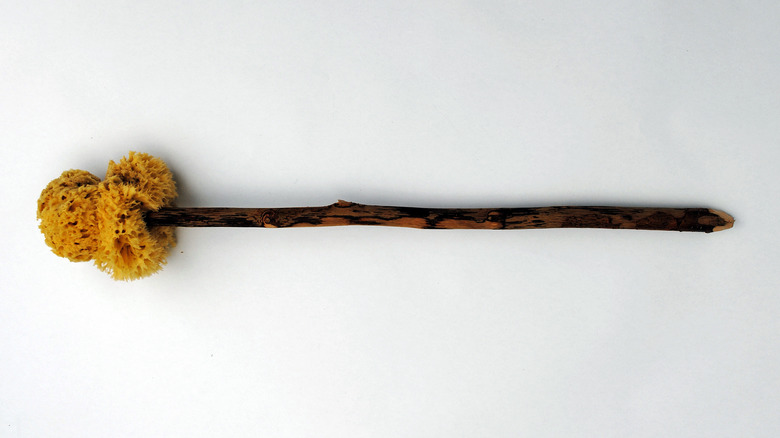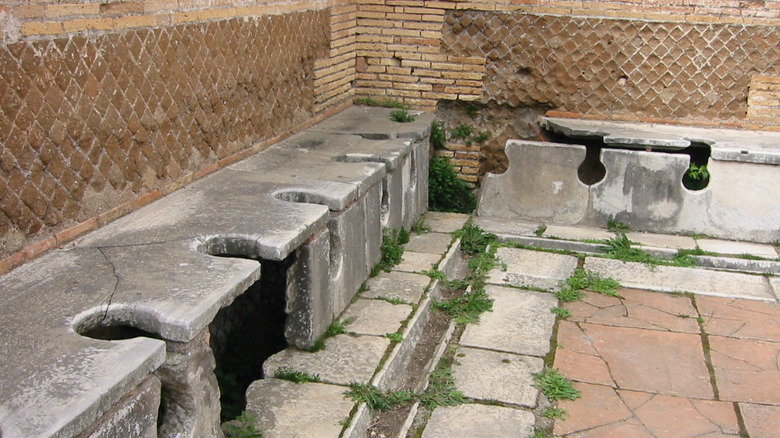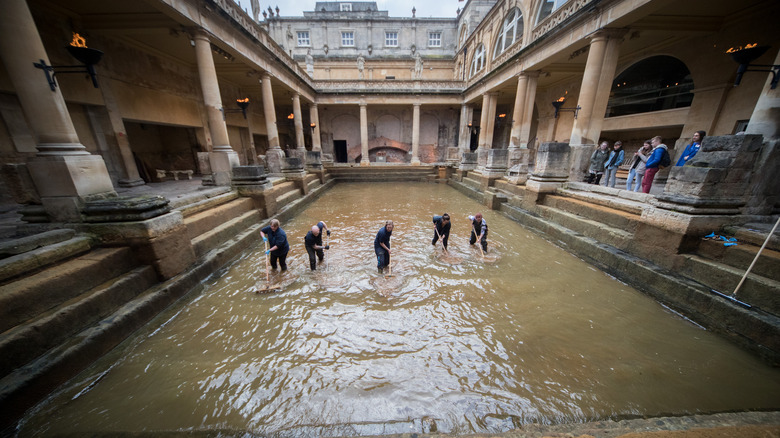The Disgusting Way Ancient Romans Cleaned Themselves After Using The Bathroom
Ah, to scent or not to scent? That's the true question. Whether 'tis suppler to wipe with lilac and vanilla, and in so doing suffer two-ply vs. three, or in taking the thinner of choices gain length but pay more; and by unrolling such sheets, finally to flush.
Shakespeare aside, yes, we do live in a fairly privileged time when it comes to butt-wiping options. Trust us when we say that you wouldn't want to live amidst pre-20th century anal cleanliness. Sticks, despite not seeming decent for wiping anything, have been a common historical choice for smearing poo away, per Live Science. We've also got leaves, grass, animal fur, hay, straw, and for art haters, tapestries. Or you could have used the gold standard choice: a handful of rocks, or even seashells. Ancient China some 2,000 years ago used slips of bamboo. Ancient Greeks used shards of ceramic that they sometimes, to add insult to excrement, inscribed with names of people they knew.
And how about those ancient Romans? Well, we hope you've got a strong stomach, because it's possibly even worse than scraping your way to hemorrhoid city. In the absence of anything remotely close to modern germ theory, the Roman way might have made sense: Take a sponge, put it on a stick, and plunge it in a bucket of vinegar, as Smithsonian Magazine explains. So far so good? Not when you consider that you'd be sharing the butt-sponge with a buddy.
A socially fecal affair
On the surface, the whole "Roman butt-wiping brush" thing still might seem better than contemporary options like shards of clay. It would take until A.D. 1596 for the first flushable toilet to exist, invented by English courtier John Harrington, as History explains. However, his version still left feces and other unmentionables hanging out in a 2-foot-deep bowl in a hole in the house. The toilet took 7.5 gallons to "flush" by manually pouring the water into it, and because such a large quantity of water was hard to come by back then, a flush only happened about once every 20 uses.
At least in Roman toilets there were some nice frescos on the wall of the poop room, and sculptures in the corner, as Sapiens describes. There were key-shaped toilet holes carved into marbles seats arrayed along all four walls of the room, and no dividers, per Pristine Sprays. And because there were no dividers, taking care of business was a social activity. You could turn to your neighbor and have a chat in between strained grunts.
Sometimes the butt-brush-stick — called a xylospongium, or tersorium (literally, "toilet brush for your butt") — was left sticking up out of the holed seats where people would sit, rather than returned to its vinegar-filled bucket. This is even worse than lazy folks nowadays not wiping the inside of the toilet bowl with a toilet brush. In fact, the tersorium looks almost exactly like a modern toilet brush.
Pooping in the bath
If sharing a fecal matter-infested butt sponge with a buddy isn't gross enough for you, that's only because we haven't discussed the spot where many people did their dirty work: public baths. As The Collector describes, baths had a variety of functions in Roman life. They were kind of like pubs, gyms, and bathhouses combined. People would meet friends and chill in the water, do some exercise, move from a hot water room to a cold water room (modern-day Japan has similar facilities, per Tsunagu Japan), hang out in saunas, and have separate rooms for changing.
All of that sounds wonderful. That is, if baths didn't also have public toilets where men — sometimes in the dark without any light — groped around for a tersorium, passed it to a buddy, and then went back into completely disinfectant-less public bath water. As The Atlantic says, despite all other Roman engineering accomplishments, its population was ridden with roundworm, whipworm, the parasite that causes dysentery, lice, fleas, bed bugs, and more, all of which got shared through the — pardon us — anus. Bathwater in bath houses was only changed periodically, and otherwise remained motionless and grew lined with scum.
The good news here? If you were among the wealthy, you could afford a personal butt-sponge, per Pristine Sprays. The only downside? You wouldn't be able to check out the graffiti scrawled into the walls by bored toilet-goers. It seems some public toilet features never change.


